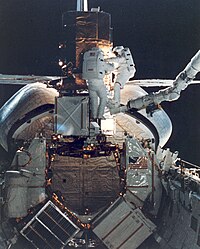George Nelson (astronaut)
George Nelson | |
|---|---|
NASA astronaut | |
Time in space | 17d 2h 43m |
| Selection | NASA Group 8 (1978) |
Total EVAs | 2 |
Total EVA time | 10h 6m[1] |
| Missions | STS-41-C STS-61-C STS-26 |
Mission insignia | |
| Retirement | June 30, 1989 |
George Driver "Pinky" Nelson (born July 13, 1950) is an American physicist, astronomer, science educator, and retired NASA astronaut.
Early life and education
Nelson was born on July 13, 1950, in Charles City, Iowa, but considers Willmar, Minnesota, to be his hometown. He graduated from Willmar Senior High School, Willmar, Minnesota, in 1968.[2] He received a Bachelor of Science degree in physics from Harvey Mudd College in 1972, and a Master of Science and a Doctor of Philosophy degrees in astronomy from the University of Washington in 1974 and 1978, respectively.[3]
Nelson was a
His wife, Susie, is from
Research
Nelson performed astronomical research at the
NASA career
George was selected as an astronaut candidate by NASA in January 1978. He flew as a scientific equipment operator in the
Spaceflight experience
STS-41-C Challenger

This was a seven-day (April 6–13, 1984) mission during which the crew successfully deployed the Long Duration Exposure Facility (LDEF), retrieved the ailing Solar Maximum satellite, repaired it on board the Orbiter, and replaced it in orbit. The mission also included flight testing of Manned Maneuvering Units (MMUs) in two extravehicular activities (EVAs), and operation of the Cinema 360 and IMAX Camera Systems. Nelson performed EVAs in support of the satellite retrieval and the MMU testing.[5]
STS-61-C Columbia
This mission, from January 12–18, 1986, launched from the Kennedy Space Center and returned to a night landing at Edwards Air Force Base, California. During the six-day flight, the crew deployed the SATCOM KU satellite and conducted experiments in astrophysics and materials processing.[6]
STS-26 Discovery
This mission (September 29–October 3, 1988) was the first flown after the Challenger accident. During the four-day flight, the crew successfully deployed the Tracking and Data Relay Satellite (TDRS-C) and operated eleven mid-deck science experiments. The mission completed 64 orbits of the Earth and landed on October 3, 1988.[7]
Post-NASA career
Nelson left NASA in June 1989, became an assistant provost at the University of Washington,[8] and now directs the Science, Mathematics and Technology Education program at Western Washington University in Bellingham. He is also the principal investigator of the North Cascades and Olympic Science Partnership, a mathematics and science partnership grant from the National Science Foundation.[9] Nelson served as faculty on the Fall 2013 Semester at Sea voyage, where he taught introductory astronomy and celestial navigation.[10]
Honors

See also
References
- ^ Pinky Nelson's EVA experience
- ^ "Pinky Nelson returns to Willmar for Hall of Fame induction". WilmarRadio.com. September 24, 2019. Retrieved December 29, 2022.
- ^ a b c d e "George D. (Nickname Pinky) Nelson (PH.D.), NASA Astronaut (Former)" (PDF). NASA. April 1989. Retrieved December 29, 2022.
- ^ "George D. Nelson at scouting.org" (PDF). Archived from the original (PDF) on 2011-06-22. Retrieved 2015-05-01.
- ^ "STS-41C Challenger". Spacefacts.de. March 27, 2000. Retrieved December 29, 2022.
- ^ "STS-61C Columbia". Spacefacts.de. Retrieved December 29, 2022.
- ^ "STS-26 Discovery". Spacefacts.de. Retrieved December 29, 2022.
- ^ Stricherz, Vince. UW grads are astronaut candidates. Archived 2008-02-21 at the Wayback Machine University Week, 9 July 1998.
- ^ "History of SMATE". Western Washington University. Retrieved December 29, 2022.
- ^ "Fall 2013 Faculty and Staff". Semester at Sea Program. Retrieved December 29, 2022.
- ^ U.S. Astronaut Hall of Fame at KSC Visitor Complex - Astronaut Scholarship Foundation Archived 2009-05-19 at the Wayback Machine, United States Astronaut Hall of Fame, retrieved 2009-05-04
- ^ "Western's George "Pinky" Nelson elected to Washington State Academy of Sciences". Western Washington University. Retrieved December 29, 2022.
- ^ "AAAS Members Elected as Fellows". American Association for the Advancement of Science. November 30, 2012. Retrieved December 29, 2022.
